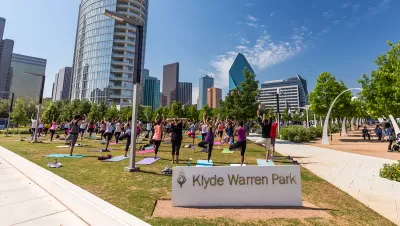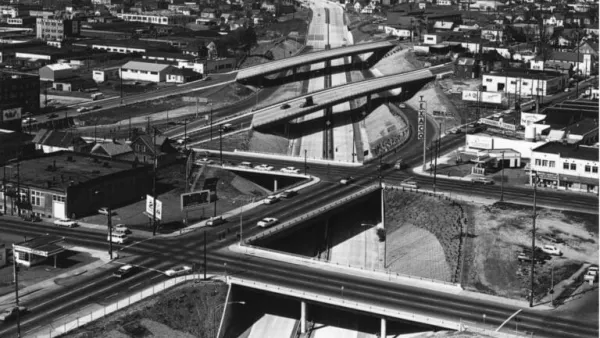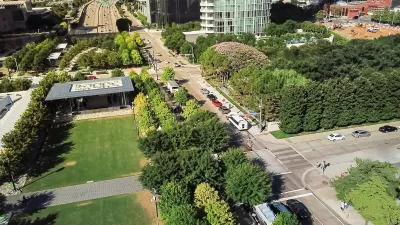Building over highways is not a particularly new idea, but it has been a rare novelty. Former SPUR director and development consultant Jim Chappell sees a brighter future for highway caps parks and projects.

With the price of urban real estate going up and up, highway airspace development becomes more viable. There are numerous projects around the country, both past and future. SPUR's former director, now a consultant, reviews a few and sees a promising future for developing in airspace over freeways and highways. He notes:
. . . there are currently 20 other parks over or replacing highways in the US and at least another 26 in some stage of proposal.
Chappell notes that while existing caps are parks or convention centers, that's changing:
In the District of Columbia, Property Group Partners are building a 7.5 acre, $1.3 billion project with five-130 foot high, mixed use commercial, office and residential buildings, totaling 2.2 million leasable square feet. All of this, plus 1.5 acres of open space, over the 3-block long, 200 foot wide, eight lane Center Leg Freeway (I-395). The lid will be completed this year, and the first building is projected to open in 2018. When complete in 2022, the project is anticipated to generate $40 million per year in property taxes alone.[4]
If $1.3 billion sounds expensive, consider Hudson Yards, two superblocks on the West side of Manhattan. Related Companies is in the midst of constructing a $25 billion 28-acre neighborhood with 18 million square feet of mixed use, all over operating rail yards. [5] $25 billion!
FULL STORY: Don’t listen to Mark Twain – freeway caps gaining traction

Maui's Vacation Rental Debate Turns Ugly
Verbal attacks, misinformation campaigns and fistfights plague a high-stakes debate to convert thousands of vacation rentals into long-term housing.

Planetizen Federal Action Tracker
A weekly monitor of how Trump’s orders and actions are impacting planners and planning in America.

In Urban Planning, AI Prompting Could be the New Design Thinking
Creativity has long been key to great urban design. What if we see AI as our new creative partner?

How Trump's HUD Budget Proposal Would Harm Homelessness Response
Experts say the change to the HUD budget would make it more difficult to identify people who are homeless and connect them with services, and to prevent homelessness.

The Vast Potential of the Right-of-Way
One writer argues that the space between two building faces is the most important element of the built environment.

Florida Seniors Face Rising Homelessness Risk
High housing costs are pushing more seniors, many of them on a fixed income, into homelessness.
Urban Design for Planners 1: Software Tools
This six-course series explores essential urban design concepts using open source software and equips planners with the tools they need to participate fully in the urban design process.
Planning for Universal Design
Learn the tools for implementing Universal Design in planning regulations.
Gallatin County Department of Planning & Community Development
Heyer Gruel & Associates PA
JM Goldson LLC
City of Camden Redevelopment Agency
City of Astoria
Transportation Research & Education Center (TREC) at Portland State University
Jefferson Parish Government
Camden Redevelopment Agency
City of Claremont





























